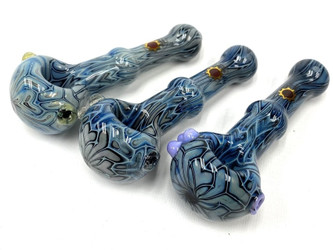Glass pipes have been a staple of the weed lover’s stash box since the days of Reefer Madness. Custom glass pipes are beautiful, functional, evocative and portable and are often the object of quiet contemplation. But just where do these iconic pieces of paraphernalia come from? This time around, Puffr's smoke shop team is taking a closer look at how these amazing pipes are made.
The Case for Custom Glass Pipes
There are a lot of reasons why aficionados of the cannabis plant choose glass pipes as their delivery vector of choice. Those reasons include:
- Glass provides a clean smoke, meaning it doesn’t transfer anything to the smoke the way a wooden pipe can.
- Glass pipes are not affected by the heat associated with smoking.
- Custom glass pipes are unique expressions of the glass maker’s art and many weed lovers collect them simply because they look so great.
Although the number of ways people enjoy cannabis and its derivatives has expanded greatly in recent years, the glass pipe endures for all those reasons and more.
How Glass Pipes are Made
The process of making a custom glass pipe eschews mechanization in favor of the tried and true methods of traditional glass blowing. Glass blowing has been around for 2,000 years and the basic techniques have changed very little in that time.
All glass pipes start when the glassblower adds heat to a tube of glass. Depending on the length of the glass tube the glassblower may create a single pipe, or break the tube into multiple sections and produce more than one.
Keep in mind that every custom glass hand pipe is different, hence the word ‘custom’. So the precise technique used to create a particular pipe will vary from one to the next.
That said, once the glassblower has the length of heated glass they are going to use to create a pipe they stretch a portion of it to create the neck. They may also spin and/or twist the neck portion to obtain a specific look.
Once the shape of the neck has been roughed in by the glassblower the glass is allowed to cool just a bit. Then heat is applied to the tube at the end of the neck. At the same time, the glassblower blows into the cool end of the neck produce an air bubble that will become the bowl.
After creating the basic shape of the bowl area from the air bubble a rod is used to press down on part of the bubble. This depression will become the bowl itself. A hole is then punched into the bottom of the bowl, linking it to the neck and mouthpiece.
In most (not all) cases another, smaller hole is punched into the side of the bowl called the 'carb hole'. After doing this, the glassblower will sometimes place the hot bubble down onto a hard surface to create a flat bottom so the bowl will be more stable when set down.
At this point, the basic pipe has been created. The glassblower may choose to add other touches to the design before breaking it off from the remainder of the glass tube, smoothing out the ends and then letting the finished pipe cool.
About Those ‘Added Touches’
As we mentioned, once the basic size and shape of the pipe has been established the glassblower may decide to add some signature touches to their creation. These unique touches are the result of further manipulation of the glass material while it is still hot.
That further manipulation may include blowing into the hot tube at strategic points to create one of a kind surface features, or manipulating the exterior of the pipe while hot to produce or augment such features.
Color may also be added to the custom glass pipe by adding bits of colored glass directly onto the heated surface which become permanent when the pipe cools. In some cases, the glassblower may decide to augment the design even further by adding precious or decorative metals to the mix.
This is done by a process known as ‘fuming’. With fuming, a small amount of metal - be it silver, gold or whatever - is held close to the heat source and the pipe held in line with the heat source but a few inches further back.
The heat vaporizes the metal and then carries those metal-infused vapors into the pipe where the metal particles join with the hot glass surface. A multitude of effects can be achieved this way, although fuming tends to increase the price of the pipe.
Fuming is just one way the makers of custom glass pipes add visual interest to their creations. They may also fuse separate pieces of molten glass to the exterior of the pipe and manipulate them to add decorative flourishes.
Conclusion
In the end, the custom glass pipe is a unique expression of the glass blower’s art and a one of a kind tool for enjoying your favorite cannabis product. They also reflect the down to earth nature of cannabis while at the same time providing objects of fascination to ponder while enjoying your buzz.
While machine-made pipes will certainly provide a dependable method for enjoying your weed, they tend to lack the soul of a good custom pipe. Which is why, for many people, it's custom glass or no glass.

 US Dollar
US Dollar
